Indo-Parthian Kingdom
The Indo-Parthian Kingdom, also known as the Suren Kingdom,[1] was a Parthian kingdom founded by the Gondopharid branch of the House of Suren, ruling from 19 to c. 224/5. At their zenith, they ruled an area covering parts of eastern Iran, various parts of Afghanistan and the northwest regions of the Indian subcontinent (parts of modern Pakistan and northwestern India).
Indo-Parthian Kingdom | |||||||||||||
|---|---|---|---|---|---|---|---|---|---|---|---|---|---|
| 19–224/5 | |||||||||||||
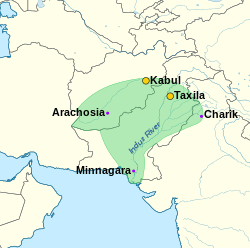 Indo-Parthian Kingdom at its maximum extent. | |||||||||||||
| Capital | Taxila Kabul | ||||||||||||
| Common languages | Aramaic Greek Pali (Kharoshthi script) Sanskrit, Prakrit (Brahmi script) Parthian | ||||||||||||
| Religion | Buddhism Hinduism | ||||||||||||
| Government | Monarchy | ||||||||||||
| King | |||||||||||||
• 19–46 | Gondophares I (first) | ||||||||||||
• ?–224/5 | Farn-Sasan (last) | ||||||||||||
| Historical era | Antiquity | ||||||||||||
| 19 | |||||||||||||
• Disestablished | 224/5 | ||||||||||||
| |||||||||||||
| Outline of South Asian history | ||||||||||||||||||||||||||||||||||||||||||||
|---|---|---|---|---|---|---|---|---|---|---|---|---|---|---|---|---|---|---|---|---|---|---|---|---|---|---|---|---|---|---|---|---|---|---|---|---|---|---|---|---|---|---|---|---|
_without_national_boundaries.svg.png) | ||||||||||||||||||||||||||||||||||||||||||||
|
Palaeolithic (2,500,000–250,000 BC) |
||||||||||||||||||||||||||||||||||||||||||||
|
Neolithic (10,800–3300 BC)
|
||||||||||||||||||||||||||||||||||||||||||||
|
Chalcolithic (3500–1500 BC)
|
||||||||||||||||||||||||||||||||||||||||||||
|
Bronze Age (3300–1300 BC)
|
||||||||||||||||||||||||||||||||||||||||||||
|
Iron Age (1500–200 BC)
|
||||||||||||||||||||||||||||||||||||||||||||
|
Middle Kingdoms (230 BC – AD 1206) |
||||||||||||||||||||||||||||||||||||||||||||
|
Late medieval period (1206–1526)
|
||||||||||||||||||||||||||||||||||||||||||||
|
Early modern period (1526–1858)
|
||||||||||||||||||||||||||||||||||||||||||||
|
Colonial states (1510–1961)
|
||||||||||||||||||||||||||||||||||||||||||||
|
Periods of Sri Lanka
|
||||||||||||||||||||||||||||||||||||||||||||
|
Specialised histories |
||||||||||||||||||||||||||||||||||||||||||||
The kingdom was founded in 19 when the Surenid governor of Drangiana (Sakastan) Gondophares declared independence from the Parthian Empire. He would later make expeditions into the west, conquering territory from the Indo-Scythians and Indo-Greeks, thus transforming his kingdom into an empire.[2] The domains of the Indo-Parthians were greatly reduced following the invasions of the Kushans in the second half of the 1st. century. They managed to retain control of Sakastan, until its conquest by the Sasanian Empire in c. 224/5.[3]
The Indo-Parthians are noted for the construction of the Buddhist monastery Takht-i-Bahi (UNESCO World Heritage Site).
Gondophares I and his successors
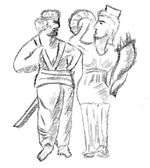
Gondophares I originally seems to have been a ruler of Seistan in what is today eastern Iran, probably a vassal or relative of the Apracarajas. Around 20–10 BC,[5] he made conquests in the former Indo-Scythian kingdom, perhaps after the death of the important ruler Azes. Gondophares became the ruler of areas comprising Arachosia, Seistan, Sindh, Punjab, and the Kabul valley, but it does not seem as though he held territory beyond eastern Punjab.[6] Gondophares called himself "King of Kings", a Parthian title that in his case correctly reflects that the Indo-Parthian empire was only a loose framework: a number of smaller dynasts certainly maintained their positions during the Indo-Parthian period, likely in exchange for their recognition of Gondophares and his successors. These smaller dynasts included the Apracarajas themselves, and Indo-Scythian satraps such as Zeionises and Rajuvula, as well as anonymous Scythians who struck imitations of Azes coins. The Ksaharatas also held sway in Gujarat, perhaps just outside Gondophares' dominions.
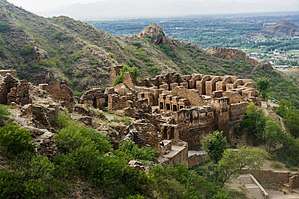
After the death of Gondophares I, the empire started to fragment. The name or title Gondophares was adapted by Sarpedones, who become Gondophares II and was possibly son of the first Gondophares. Even though he claimed to be the main ruler, Sarpedones’ rule was shaky and he issued a fragmented coinage in Sind, eastern Punjab and Arachosia in southern Afghanistan. The most important successor was Abdagases, Gondophares’ nephew, who ruled in Punjab and possibly in the homeland of Seistan. After a short reign, Sarpedones seems to have been succeeded by Orthagnes, who became Gondophares III Gadana. Orthagnes ruled mostly in Seistan and Arachosia, with Abdagases further east, during the first decades AD, and was briefly succeeded by his son Ubouzanes Coin. After 20 AD, a king named Sases, a nephew of the Apracaraja ruler Aspavarma, took over Abdagases’ territories and became Gondophares IV Sases. According to Senior, this is the Gondophares referred to in the Takht-i-Bahi inscription.[7]
There were other minor kings: Sanabares was an ephemeral usurper in Seistan, who called himself Great King of Kings, and there was also a second Abdagases Coin, a ruler named Agata in Sind, another ruler called Satavastres Coin, and an anonymous prince who claimed to be brother of the king Arsaces, in that case an actual member of the ruling dynasty in Parthia.
But the Indo-Parthians never regained the position of Gondophares I, and from the middle of the 1st century AD the Kushans under Kujula Kadphises began absorbing the northern Indian part of the kingdom. The Indo-Parthians managed to retain control of Sakastan, which they ruled until the fall of the Parthian Empire by Sasanian Empire.[8]
Archaeology and sources
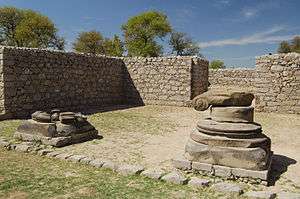
The city of Taxila is thought to have been a capital of the Indo-Parthians. Large strata were excavated by Sir John Marshall with a quantity of Parthian-style artifacts. The nearby temple of Jandial is usually interpreted as a Zoroastrian fire temple from the period of the Indo-Parthians.
Some ancient writings describe the presence of the Indo-Parthians in the area, such as the story of Saint Thomas the Apostle, who was recruited as a carpenter to serve at the court of king "Gudnaphar" (thought to be Gondophares) in India. The Acts of Thomas describes in chapter 17 Thomas' visit to king Gudnaphar in northern India; chapters 2 and 3 depict him as embarking on a sea voyage to India, thus connecting Thomas to the west coast of India.
As Senior points out,[9] this Gudnaphar has usually been identified with the first Gondophares, who has thus been dated after the advent of Christianity, but there is no evidence for this assumption, and Senior's research shows that Gondophares I could be dated even before 1 AD. If the account is even historical, Saint Thomas may have encountered one of the later kings who bore the same title.
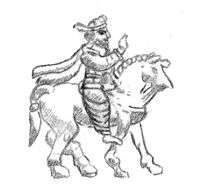
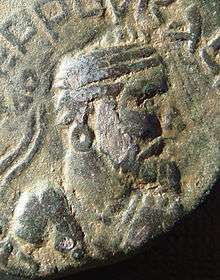
The Greek philosopher Apollonius of Tyana is related by Philostratus in Life of Apollonius Tyana to have visited India, and specifically the city of Taxila around 46 AD. He describes constructions of the Greek type,[10] probably referring to Sirkap, and explains that the Indo-Parthian king of Taxila, named Phraotes, received a Greek education at the court of his father and spoke Greek fluently:
- "Tell me, O King, how you acquired such a command of the Greek tongue, and whence you derived all your philosophical attainments in this place?"[11]
- [...]-"My father, after a Greek education, brought me to the sages at an age somewhat too early perhaps, for I was only twelve at the time, but they brought me up like their own son; for any that they admit knowing the Greek tongue they are especially fond of, because they consider that in virtue of the similarity of his disposition he already belongs to themselves."[12]
The Periplus of the Erythraean Sea is a surviving 1st century guide to the routes commonly being used for navigating the Arabian Sea. It describes the presence of Parthian kings fighting with each other in the area of Sindh, a region traditionally known at that time as "Scythia" due to the previous rule of the Indo-Scythians there:
- "This river (Indus) has seven mouths, very shallow and marshy, so that they are not navigable, except the one in the middle; at which by the shore, is the market-town, Barbaricum. Before it there lies a small island, and inland behind it is the metropolis of Scythia, Minnagara; it is subject to Parthian princes who are constantly driving each other out." Periplus of the Erythraean Sea, Chap 38[13]
An inscription from Takht-i-Bahi bears two dates, one in the regnal year 26 of the Maharaja Guduvhara (again thought to be a Gondophares), and the year 103 of an unknown era.[14]
Religion of the Indo-Parthians
We do not know the religion of the House of Suren although we know they were in religious conflict with the Zoroastrian Arsacid Dynasty.[15] Unlike the Indo-Greeks or Indo-Scythians, there are no explicit records of Indo-Parthian rulers supporting Buddhism, such as religious dedications, inscriptions, or even legendary accounts. Also, although Indo-Parthian coins generally closely follow Greek numismatics, they never display the Buddhist triratna symbol (apart from the later Sases), nor do they ever use depictions of the elephant or the bull, possible religious symbols which were profusely used by their predecessors. They are thought to have retained Zoroastrianism, being of Iranian extraction themselves. This Iranian mythological system was inherited from them by the later Kushans who ruled from the Peshawar-Khyber-Pakhtunkhwa region of Pakistan.
Coins of the Hindu deity Shiva have also been found issued in the reign of Gondophares I.[16][17][18]
Representation of Indo-Parthian devotees
On their coins and in the art of Gandhara, Indo-Parthians are depicted with short crossover jackets and large baggy trousers, possibly supplemented by chap-like over-trousers.[19] Their jackets are adorned with rows of decorative rings or medals. Their hair is usually bushy and contained with a headband, a practise largely adopted by the Parthians from the 1st century AD.[20]
Individuals in Indo-Parthian attire are sometimes shown as actors in Buddhist devotional scenes. It is usually considered that most of the excavations that were done at Sirkap near Taxila by John Marshall relate to Indo-Parthian layers, although more recent scholarship sometimes relates them to the Indo-Greeks instead.[21] These archaeological researches provided a quantity of Hellenistic artifacts combined with elements of Buddhist worship (stupas). Some other temples, such as nearby Jandial may have been used as a Zoroastrian fire temple.
Buddhist sculptures
The statues found at Sirkap in the late Scythian to Parthian level (level 2, 1–60 AD) suggest an already developed state of Gandharan art at the time or even before Parthian rule. A multiplicity of statues, ranging from Hellenistic gods, to various Gandharan lay devotees, are combined with what are thought as some of the early representations of the Buddha and Bodhisattvas. Today, it is still unclear when the Greco-Buddhist art of Gandhara exactly emerged, but the findings in Sirkap do indicate that this art was already highly developed before the advent of the Kushans.
Stone palettes
Numerous stone palettes found in Gandhara are considered as good representatives of Indo-Parthian art. These palettes combine Greek and Persian influences, together with a frontality in representations which is considered as characteristic of Parthian art. Such palettes have only been found in archaeological layers corresponding to Indo-Greek, Indo-Scythian and Indo-Parthian rule, and are essentially unknown the preceding Mauryan layers or the succeeding Kushan layers.[22]
Very often these palettes represent people in Greek dress in mythological scenes, but a few of them represent people in Parthian dress (head-bands over bushy hair, crossed-over jacket on a bare chest, jewelry, belt, baggy trousers). A palette from the Naprstek Museum in Prague shows an Indo-Parthian king seated crossed-legged on a large sofa, surrounded by two attendants also in Parthian dress. They are shown drinking and serving wine.
- Indo-Parthian man hunting.
- Indo-Parthian revelers.
- Indo-Parthian couple.
Silk Road transmission of Buddhism
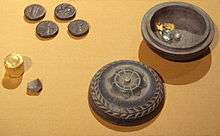
Some pockets of Parthian rule remained in the East, even after the takeover by the Sassanids in 226. From the 2nd century several Central-Asian Buddhist missionaries appeared in the Chinese capital cities of Loyang and sometimes Nanjing, where they particularly distinguished themselves by their translation work. The first known translators of Buddhist texts into Chinese are actually Parthian missionaries, distinguished in Chinese by their Parthian surname "An", for "Anshi", "country of the Arsacids".
Main Indo-Parthian rulers


- Gondophares I (c. 19 – 46) Coin
- Gondophares II Sarpedones (first years AD – c. 20 AD)Coin
- Abdagases I (first years AD – mid-1st century AD) Coin
- Gondophares III Gudana, previously Orthagnes (c. 20 AD – 30 AD)
- Gondophares IV Sases, (mid-1st century AD)
- Ubouzanes, (late-1st century AD)
- Pacores (late 1st century AD) Coin
Notes
- Gazerani 2015, p. 26.
- Rezakhani 2017, p. 35.
- Olbrycht 2016, p. 25.
- Photographic reference: "The dynastic art of the Kushans", Rosenfield, figures 278–279
- The chronology of the Gondopharid kings has long been uncertain, predominantly based on coins. This reconstruction is based on "Indo-Scythian Coins and History IV" by Robert Senior, CNG 2006, as the four volumes of Senior's work provide an almost complete catalogue of the coinage of the period. Senior's chronology is based on the existence of only one king Azes, a theory that was vindicated when it was shown that a coin of the so-called Azes II was overstruck with a type attributed to Azes I (see Senior, "The final nail in the coffin of Azes II", Journal of the Oriental Numismatic Society 197, 2008).
- Rosenfield, p129
- A votive inscription of the 26th year of Gudavhara or Gondophares, is reported to have been found on a stone at Takht-i-Bahi, northeast of Peshawar with a date in the year 103 of an unspecified era reckoning. This era is likely to have been the Malva or Vikrama era, founded in 57 BCE, this would give a date of 20 CE for this king's ascension (see Hindu calendar). The stone was formerly in the museum at Lahore. The point is especially important for those Christians who consider that a germ of history is embedded in the Acts of Thomas.
- Gazerani 2015, pp. 26-27.
- see Senior, "The final nail in the coffin of Azes II".
- Description of the Hellenistic urbanism of Taxila:
- "Taxila, they tell us, is about as big as Nineveh, and was fortified fairly well after the manner of Greek cities" (Life of Apollonius Tyana, II 20)
- "I have already described the way in which the city is walled, but they say that it was divided up into narrow streets in the same irregular manner as in Athens, and that the houses were built in such a way that if you look at them from outside they had only one story, while if you went into one of them, you at once found subterranean chambers extending as far below the level of the earth as did the chambers above." (Life of Apollonius Tyana, II 23)
- (Life of Apollonius Tyana, II 29)
- (Life of Apollonius Tyana, II 31)
- Periplus of the Erythraean Sea, Chap 38
- Rosenfield, p130.
- Gazerani, Saghi. The Sistani cycle of epics and Iran's national history : on the margins of historiography. Brill. p. 111. ISBN 9789004282964. Retrieved 9 January 2019.
- Gondophares I Indological researches in India: selected works of Prof. K.D. Bajpai
- Anthropological Papers of the American Museum of Natural History, Volume 46 Pg. 274
- Described in "Rome's enemies, Parthians and Sassanid Persians", ISBN 0-85045-688-6
- "Parthians, from about the 1st century AD, seem to have preferred to show off their carefully tonsured hair, usually only wearing a fillet of thick ribbon; before then, the Scythian cap or bashlyk was worn more frequently". In "Parthians and Sassanid Parthians" Peter Willcox ISBN 0-85045-688-6, p12
- Pierfrancesco Gallieri, in "Crossroads of Asia": "The parallels are so striking that it is not excluded that the objects discovered in Taxila and dated to between the 1st century BCE and the 1st century CE were in reality produced earlier, maybe by artisans who had followed the Greeks kings during their retreat from Bactria to India" p211 (in French in the original)
- "Let us remind that in Sirkap, stone palettes were found at all excavated levels. On the contrary, neither Bhir-Mound, the Maurya city preceding Sirkap on the Taxila site, nor Sirsukh, the Kushan city succeeding her, did deliver any stone palettes during their excavations", in "Les palettes du Gandhara", p89. "The terminal point after which such palettes are not manufactured anymore is probably located during the Kushan period. In effect, neither Mathura nor Taxila (although the Sirsukh had only been little excavated), nor Begram, nor Surkh Kotal, neither the great Kushan archaeological sites of Soviet Central Asia or Afghanistan have yielded such objects. Only four palettes have been found in Kushan-period archaeological sites. They come from secondary sites, such as Garav Kala and Ajvadz in Soviet Tajikistan and Jhukar, in the Indus Valley, and Dalverzin Tepe. They are rather roughly made." In "Les Palettes du Gandhara", Henri-Paul Francfort, p91. (in French in the original)
References
- "Les Palettes du Gandhara", Henri-Paul Francfort, Diffusion de Boccard, Paris, 1979
- "Reports on the campaigns 1956–1958 in Swat (Pakistan)", Domenico Faccenna
- "Sculptures from the sacred site of Butkara I", Domenico Faccena
Sources
- Bosworth, Clifford Edmund (1997). "Sīstān". The Encyclopedia of Islam, New Edition, Volume IX: San–Sze. Leiden, and New York: BRILL. pp. 681–685. ISBN 9789004082656.CS1 maint: ref=harv (link)
- Schmitt, R. (1995). "DRANGIANA". Encyclopaedia Iranica, Vol. II, Fasc. 5. pp. 534–537.CS1 maint: ref=harv (link)
- Frye, Richard Nelson (1984). The History of Ancient Iran. C.H.Beck. pp. 1–411. ISBN 9783406093975.
The history of ancient iran.
CS1 maint: ref=harv (link) - Gazerani, Saghi (2015). The Sistani Cycle of Epics and Iran’s National History: On the Margins of Historiography. BRILL. pp. 1–250. ISBN 9789004282964.CS1 maint: ref=harv (link)
- Bivar, A. D. H. (2002). "GONDOPHARES". Encyclopaedia Iranica, Vol. XI, Fasc. 2. pp. 135–136.CS1 maint: ref=harv (link)
- Olbrycht, Marek Jan (2016). "Dynastic Connections in the Arsacid Empire and the Origins of the House of Sāsān". In Curtis, Vesta Sarkhosh; Pendleton, Elizabeth J.; Alram, Michael; Daryaee, Touraj (eds.). The Parthian and Early Sasanian Empires: Adaptation and Expansion. Oxbow Books. ISBN 9781785702082.CS1 maint: ref=harv (link)
- Rezakhani, Khodadad (2017). ReOrienting the Sasanians: East Iran in Late Antiquity. Edinburgh University Press. pp. 1–256. ISBN 9781474400305.CS1 maint: ref=harv (link)
External links
| Wikimedia Commons has media related to Indo-Parthian. |
| Timeline and cultural period |
Northwestern India (Punjab-Sapta Sindhu) |
Indo-Gangetic Plain | Central India | Southern India | ||
| Upper Gangetic Plain (Ganga-Yamuna doab) |
Middle Gangetic Plain | Lower Gangetic Plain | ||||
| IRON AGE | ||||||
| Culture | Late Vedic Period | Late Vedic Period (Srauta culture)[lower-alpha 1] Painted Grey Ware culture |
Late Vedic Period (Shramanic culture)[lower-alpha 2] Northern Black Polished Ware |
Pre-history | ||
| 6th century BC | Gandhara | Kuru-Panchala | Magadha | Adivasi (tribes) | ||
| Culture | Persian-Greek influences | "Second Urbanisation" Rise of Shramana movements Jainism - Buddhism - Ājīvika - Yoga |
Pre-history | |||
| 5th century BC | (Persian conquests) | Shaishunaga dynasty | Adivasi (tribes) | |||
| 4th century BC | (Greek conquests) | Nanda empire | ||||
| HISTORICAL AGE | ||||||
| Culture | Spread of Buddhism | Pre-history | Sangam period (300 BC – 200 AD) | |||
| 3rd century BC | Maurya Empire | Early Cholas Early Pandyan Kingdom Satavahana dynasty Cheras 46 other small kingdoms in Ancient Thamizhagam | ||||
| Culture | Preclassical Hinduism[lower-alpha 3] - "Hindu Synthesis"[lower-alpha 4] (ca. 200 BC - 300 AD)[lower-alpha 5][lower-alpha 6] Epics - Puranas - Ramayana - Mahabharata - Bhagavad Gita - Brahma Sutras - Smarta Tradition Mahayana Buddhism |
Sangam period (continued) (300 BC – 200 AD) | ||||
| 2nd century BC | Indo-Greek Kingdom | Shunga Empire Maha-Meghavahana Dynasty |
Early Cholas Early Pandyan Kingdom Satavahana dynasty Cheras 46 other small kingdoms in Ancient Thamizhagam | |||
| 1st century BC | ||||||
| 1st century AD | Kuninda Kingdom | |||||
| 2nd century | Kushan Empire | |||||
| 3rd century | Kushano-Sasanian Kingdom | Kushan Empire | Western Satraps | Kamarupa kingdom | Kalabhra dynasty Pandyan Kingdom (Under Kalabhras) | |
| Culture | "Golden Age of Hinduism"(ca. AD 320-650)[lower-alpha 7] Puranas Co-existence of Hinduism and Buddhism | |||||
| 4th century | Kidarites | Gupta Empire Varman dynasty |
Kalabhra dynasty Pandyan Kingdom (Under Kalabhras) Kadamba Dynasty Western Ganga Dynasty | |||
| 5th century | Hephthalite Empire | Alchon Huns | Kalabhra dynasty Pandyan Kingdom (Under Kalabhras) Vishnukundina | |||
| 6th century | Nezak Huns Kabul Shahi |
Maitraka | Adivasi (tribes) | Badami Chalukyas Kalabhra dynasty Pandyan Kingdom (Under Kalabhras) | ||
| Culture | Late-Classical Hinduism (ca. AD 650-1100)[lower-alpha 8] Advaita Vedanta - Tantra Decline of Buddhism in India | |||||
| 7th century | Indo-Sassanids | Vakataka dynasty Empire of Harsha |
Mlechchha dynasty | Adivasi (tribes) | Pandyan Kingdom (Under Kalabhras) Pandyan Kingdom(Revival) Pallava | |
| 8th century | Kabul Shahi | Pala Empire | Pandyan Kingdom Kalachuri | |||
| 9th century | Gurjara-Pratihara | Rashtrakuta dynasty Pandyan Kingdom Medieval Cholas Pandyan Kingdom (Under Cholas) Chera Perumals of Makkotai | ||||
| 10th century | Ghaznavids | Pala dynasty Kamboja-Pala dynasty |
Kalyani Chalukyas Medieval Cholas Pandyan Kingdom (Under Cholas) Chera Perumals of Makkotai Rashtrakuta | |||
References and sources for table References
Sources
| ||||||